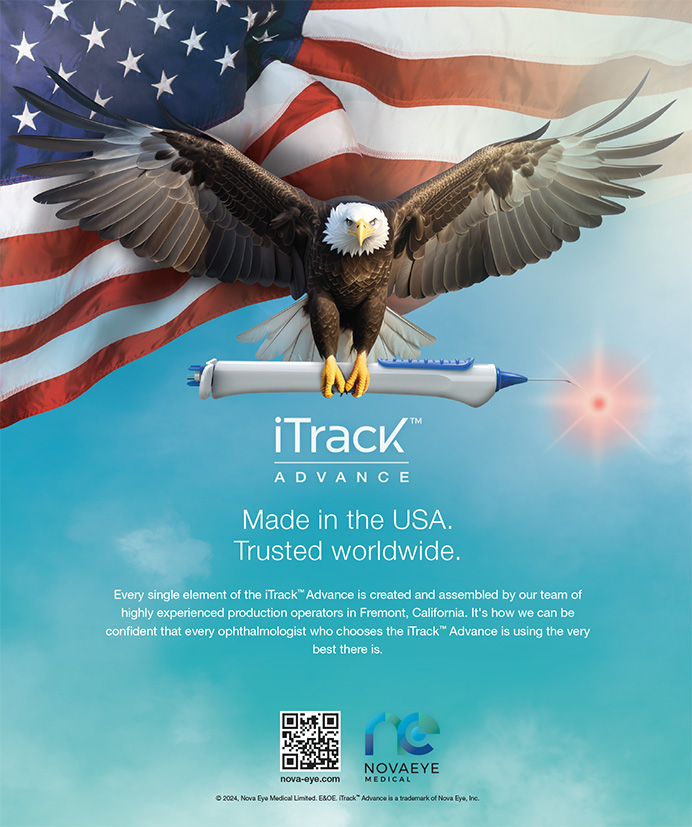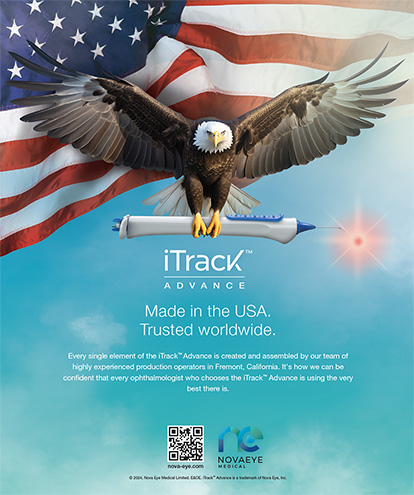AcuFocus
The Kamra inlay is a first-in-class device for the correction of presbyopia. What unique challenges did the company face in defining a new class of medical device?

Nick Tarantino, OD, chief clinical research and regulatory officer: The biggest hurdle with a first-of-its-kind product is that development and regulatory testing follow parallel trajectories. In our case, we continued to optimize the implantation procedure as a result of our early experiences in clinical trials, so the results improved as the surgery was refined. As tricky as that was, I think the fact that we were able to refine the surgical procedure is what ultimately helped to demonstrate to the FDA the safety and effectiveness of the Kamra inlay.
We made two significant changes to the procedure: (1) an adjustment to the depth at which the inlay was placed to induce a minimal biologic response while still being effective and (2) the incorporation of a femtosecond laser-created pocket to induce a much smoother bed. Both of these changes helped improve the effectiveness of the procedure while optimizing the safety profile. Although not an absolute measure, the fact that the subjective responses continued to get better as we got closer to market is an indication of how successful these refinements in the procedure were for delivering what patients and surgeons expected.
Can you take us behind the scenes? What sorts of discussions occur between a company like AcuFocus and the FDA that facilitate the development of clinical trials and/or navigation of the regulatory process? How early is the FDA involved in the process, and does the agency stay engaged?
Dr. Tarantino: Our first contact with the FDA for the Kamra was a meeting in advance of the Investigational Device Exemption (IDE) filing, about 1 year before we initiated clinical trials (see The IDE Explained), during which we got a good understanding of FDA requirements, reviewed and explained the way we wanted to test the product, and received feedback from the FDA. The FDA stayed involved throughout, which proved to be tremendously beneficial for successful commercialization. The FDA has made a concerted effort to help products make it through the pipeline. In our case, the FDA provided valuable insights and advice that shaped how we designed clinical trials, collected our data, and presented them to the regulatory body and its advisory committee.
AcuFocus, like many companies, sought and received a CE Mark for the Kamra prior to seeking FDA approval. Why did AcuFocus choose this strategy, and what benefit does this approach provide? Is it simply a matter of its being easier to get the CE Mark? Does CE Mark status have any influence on FDA approval?
Dr. Tarantino: Companies may seek a CE Mark first for a variety of reasons. In our case, what a stepwise approach provided was a means to collect additional data to [increase] our understanding of the inlay in the clinical setting. Once it was commercialized under the CE Mark, there were greater numbers of patients having the procedure, and more surgeons gained access to the product. A lot of the refinements in the procedure really came about as a result of those first market experiences.
At the time we applied for a CE Mark, a lot of the requirements for approval were based on the preclinical data and much of the early-phase clinical data—all of which we would later submit to the FDA. So, there was some crossover, and it helped establish good assurance that the product was safe and effective prior to getting the CE Mark. In a sense, it helped us get organized and start to demonstrate to potential future customers the safety and efficacy of the Kamra inlay.
THE IDE EXPLAINED
The Investigational Device Exemption (IDE) is a critical step in the regulatory pathway, as it permits the sponsor to enter into clinical trials that test the safety and efficacy of the device.
According to the FDA, “An [IDE] allows the investigational device to be used in a clinical study in order to collect safety and effectiveness data. … All clinical evaluations of investigational devices, unless exempt, must have an approved IDE before the study is initiated.”
For more, visit http://tinyurl.com/h9292ht.
When the inlay was reviewed by the Ophthalmic Devices Advisory Committee, the panel overwhelmingly agreed on the device’s efficacy but suggested an indication only for individuals who did not require glasses for distance vision. What was the rationale, and how did this request affect the product’s development arc?
Dr. Tarantino: Our study protocol defined our patient population as individuals with a refractive error between -0.75 and +0.50 D. In our view, that range of vision constituted the ideal candidate for the inlay. On a practical level, we also had to limit the amount of testing we did so that we could demonstrate safety and a benefit. So, that request from the advisory committee really comes from the fact that those are the kinds of patients we enrolled in the clinical trials: individuals who did not need glasses for distance vision.
Many products do not make it through the approval process. Aside from the benefits that the inlay provides, to what do you attribute AcuFocus’ success in gaining approval in the United States?
Dr. Tarantino: I would say that the FDA process itself was instrumental. It may surprise some people to hear me say that, yet absent the scrutiny of the regulatory requirements themselves, we [might] not have been challenged in the same way to stratify the trial data and look at [them] in different ways. The questions the FDA and its advisory panel posed provided the framework that guided a continual learning process about which cases the product is successful in and in which cases the product might not be as successful. Throughout the regulatory process, and especially during our presentation to the Ophthalmic Advisory Panel, the agency and committee members raised several questions—some of them challenging questions—that we had to address or risk getting derailed. I believe it was our ability to continually answer those questions in a timely manner that played a big part in gaining approval.
Did the company learn anything in its efforts with the inlay that will guide future development projects, and are there areas in which the regulatory process can facilitate market innovation?
Dr. Tarantino: There is always something to learn. In our case, one of the things we learned was the importance of a good patient-reported outcome instrument for use in clinical trials. We have a much better understanding of what we need to do in the future.
In terms of the future regulatory process, one of the things that the FDA is doing really well now is getting involved in the process of trying to develop codified standards for drug and device development. The FDA is helping to prepare guidance for new products, and it is being very proactive with that commitment. That has already been an assist to industry, and it promises to be even more beneficial as those standards are established.
Ocular Therapeutix
The FDA approved the ReSure Sealant for use to prevent “postoperative fluid egress from incisions with a demonstrated wound leak following cataract surgery.” That is pretty specific language for a product designed to seal the clear corneal incision. What is the origin of that kind of verbiage? Is it a result of conversation with the FDA?

Amar Sawhney, PhD, president, CEO, and chairman of the board of directors, Ocular Therapeutix: The ReSure Sealant was approved through the premarket approval (PMA) pathway, which, by definition, means that it is a novel product that does not have a predicate. When we conducted a trial for safety and efficacy that included more than 500 subjects, 488 of whom had leakage at the time of cataract surgery, we studied the product in the setting of leaking clear corneal incisions after cataract surgery. As a consequence, the label that was ultimately granted is confined to the population in which the product was tested. A specific example of that would be the limitation of the size of the incision (< 3.5 mm in the study); we were directed to include that specificity in the labeling language. That is not to say that the sealant may or may not work in that or other settings, only that it was tested in those specific areas.
How early in product development did Ocular Therapeutix engage the FDA for guidance on the regulatory pathway? Was this timing typical of when companies usually engage the FDA?
Dr. Sawhney: The FDA encourages early interaction, and we did just that. As it turns out, we were fortunate to have started a dialogue with the agency early in our process, as that engagement helped us build a relationship that helped smooth out some difficulties we encountered. Early interaction is now becoming typical in my opinion, or if not, I believe it should be.
Did you encounter any unexpected obstacles in the regulatory pathway, and how did they affect the path to approval?
Dr. Sawhney: Every company, I am sure, encounters some speed bumps, and we certainly had an interesting path to approval.
When we first engaged the FDA, the product was called the I-ZIP Ocular Bandage, and we were pursuing a 510(k) pathway—which differs from PMA in that there is a predicate. When we held a pre-IDE meeting with the FDA, it was determined that a 510(k) pathway comparing [our product] with a predicate device (specifically, a collagen corneal shield) was appropriate. Based on that, we conducted a 420-patient trial to be able to evaluate our product. Unfortunately, at the close of that trial, circumstances at the FDA changed, and when we submitted our application based on that trial’s outcome, [the] FDA made the determination that the company must study the product as a sealant, a product without a predicate. This was obviously disappointing [to] and troubling for us because we had invested so much time and effort in our 510(k) study.
At that point, we were faced with abandoning the project or doing a separate clinical trial if we wanted to make this product available to clinicians. [With the product studied] as a sealant, because there was no predicate, we would have to pursue an alternate pathway. We again engaged the FDA in a pre-IDE meeting to start down the PMA pathway and then conducted another clinical study, this time with 488 subjects.
The results of that second study are what we presented to the Ophthalmic Advisory Panel convened by FDA in review of our PMA submission. That panel recommended our product for approval, but [it] also suggested we conduct postmarketing surveillance studies to see what impact the sealant [might] have on adverse event rates and, more specifically, on the rate of endophthalmitis. The conditions of approval for our PMA were quite stringent and fairly extensive, and we are honoring them by conducting a standard postapproval study and also working with [the] FDA on a registry trial.
Can you provide any insight into the design of the clinical trials for ReSure Sealant and how it contributed to regulatory approval? What sort of planning is involved in designing a successful clinical trial?
Dr. Sawhney: The predecessor to the ReSure Sealant, the I-ZIP Ocular Bandage, was actually granted CE Mark approval, so we had extensive experience [with] and use of the product in patients in Europe. When we were asked by the FDA to reclassify the product, we were in a position to appropriately design a clinical study because we knew a great deal about the product at that point.
In an ocular surgery such as cataract removal, wounds leak quite frequently postoperatively, more than conventional wisdom suggests. Based on that, we [decided] to test the sealant’s ability to prevent egress. We designed a special device, a calibrated force gauge, which applied a controlled amount of pressure directly to the ocular surface, just outside the limbus. At the end of the surgery, the surgeon would place the device on the eye to see if the incision was potentially leaking. We found that 49% of wounds leaked spontaneously, and 98% wounds leaked when force was applied using the gauge. Patients with leaking incisions were randomized 2:1 to sealant or sutures. The primary endpoint was to see how many of those incisions were still leaking after treatment (either sealant or sutures) was applied. [Sutured eyes] still leaked about 30% to 35% of the time, and [those with] the sealant leaked only 4% of the time. So, we saw a dramatic difference between how the sealant treatment arm performed versus the control arm did with sutures.1
Those results really get back to the question about the specific labeling. We demonstrated that ReSure Sealant lowered the potential for egress, but we did not study prevention of fluid ingress. That explains why we wound up with the indication that we did.
Did your company learn any lessons from the process with ReSure Sealant that will affect how you work with the FDA in the future on other development projects?
Dr. Sawhney: As a company, we are developing drug-based products as well as device-based products. Our interaction with [the] FDA on the pharmaceutical side has been quite positive in all regards. As well, the markets we are exploring for pharmaceutical products are slightly larger than those on the device side. Based on the fact that we had to make a sizable investment of time and resources on the device side, and because, from our view, the device pathway is a little more complicated, we have made the strategic decision to prioritize pharmaceutical development for the time being.
1. Masket S, Hovanesian JA, Levenson J, et al. Hydrogel sealant versus sutures to prevent fluid egress after cataract surgery. J Cataract Refract Surg. 2014;40:2057-2066.
Glaukos
Navigating the regulatory requirements and submissions for FDA approval of a new medical device can be daunting. The intensity grows exponentially if a company is trying to introduce a new category. Glaukos submitted a PMA application for the iStent Trabecular Micro-Bypass Stent. Was the easier and faster 510(k) application not an option?

Thomas W. Burns, CEO and president, Glaukos: We decided to use iStent therapies to treat mild to moderate open-angle glaucoma, which necessitated the PMA approval path. Using an aqueous shunt as a predicate to file a 510(k) application for [the] iStent would have led to approval in a more narrow niche market and would not have established the level 1 data necessary for broad reimbursement in the commercial market. Although the 510(k) path is a viable route for many companies, we were focused on generating the data and path necessary to be able to serve a broad section of glaucoma patients and to optimize the US commercial launch of the iStent.
If you were looking for a broad market, why did you seek approval for the iStent in conjunction with cataract surgery and not as a standalone procedure?
Mr. Burns: We were challenged with proposing a regulatory path for a microinvasive procedure in which the benefit-to-risk ratio was inexorably weighed in the patient’s advantage. We proposed implanting [the] iStent in combined cataract procedures for comorbid glaucoma patients, which provided an optimized patient benefit-to-risk value proposition. We were convinced that we would be able to reach a broad segment of the market by conducting primary research using CMS [Centers for Medicare & Medicaid Services] data. We were delighted that the CMS data confirmed a broad total addressable market of comorbid glaucoma-cataract patients who could benefit from iStent treatment. After several months of negotiation with the FDA, we were able to begin enrollment of the clinical trial for the PMA.
Glaukos has been dedicated to producing sound clinical research from its inception. Did that help with the FDA approval?
Mr. Burns: Glaukos is currently conducting 17 prospective clinical trials to assess the safety and efficacy of [the] iStent in each stage of glaucoma disease severity. We believe our focus on sound science is integral to our dealings with the FDA.
It seems as if a lot of flexibility and creative problem solving were required during this process. What are some vital skills to working through a PMA application?
Mr. Burns: We worked cooperatively with the FDA to establish an entirely new area of treatment for glaucoma. In so doing, we had to confront issues of protocol design and prenegotiate benchmarks for clinical efficacy that would set the standard for other potential microinvasive glaucoma surgery (MIGS) competitors who were attracted to the market Glaukos has created. We believe that the FDA was cognizant of the regulatory precedent that our first-to-market MIGS device and novel, proposed MIGS regulatory path to the market would create, and in so doing, the agency proceeded cautiously, methodically, and with heightened scrutiny in validating our path to US approval. Throughout this process, there were multiple exchanges and discussions on what constituted safety and efficacy for this novel iStent device. A sponsor must be malleable, tenacious, and patient in order to successfully navigate the process, particularly when the company is attempting to create an entirely new clinical and commercial marketplace. In the end, the continuous exchange of new ideas established a new marketplace that ultimately benefits the glaucoma community and glaucoma patients.


